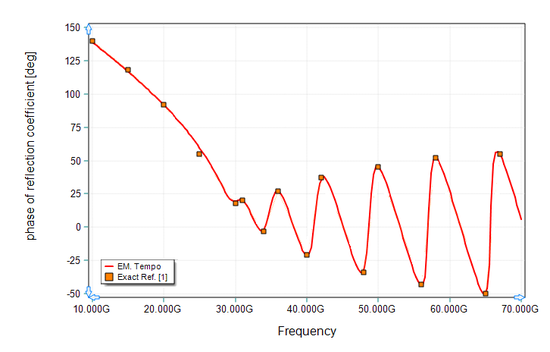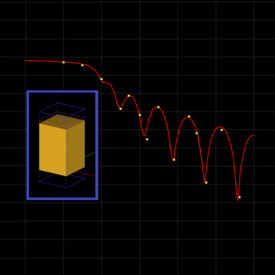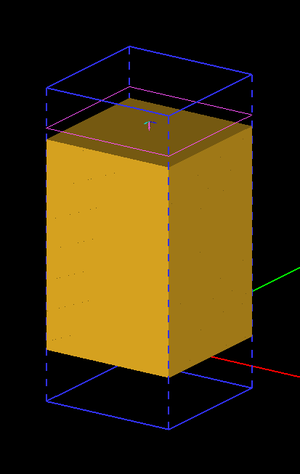Difference between revisions of "V&V Article 5: Modeling Dispersive Materials Using EM.Tempo"
Kazem Sabet (Talk | contribs) (→Introduction) |
Kazem Sabet (Talk | contribs) (→Reflection from an Infinite Slab of Dispersive Water) |
||
| Line 21: | Line 21: | ||
:<math> \varepsilon (\omega) = \varepsilon_\infty + \sum_{p=1}^N \dfrac{\Delta \varepsilon_p}{1 + j\omega \tau_p}, \quad \Delta \varepsilon_p = \varepsilon_{sp} - \varepsilon_\infty </math> | :<math> \varepsilon (\omega) = \varepsilon_\infty + \sum_{p=1}^N \dfrac{\Delta \varepsilon_p}{1 + j\omega \tau_p}, \quad \Delta \varepsilon_p = \varepsilon_{sp} - \varepsilon_\infty </math> | ||
| − | where <math>\varepsilon_{\infty}</math> is the value of the permittivity at infinite frequency, <math>\tau_p</math> is the relaxation time corresponding to the p''th'' pole having the unit of seconds, and <math>\varepsilon_{sp}</math> is the value of the static permittivity (at DC) corresponding to the p''th'' pole. <math>\Delta \varepsilon_p = \varepsilon_{sp} - \varepsilon_{\infty}</math> represents the change in permittivity due to the p''th'' pole. Water has a Debye pole with parameters τ = 9.4×10<sup>-12</sup>, ε<sub> | + | where <math>\varepsilon_{\infty}</math> is the value of the permittivity at infinite frequency, <math>\tau_p</math> is the relaxation time corresponding to the p''th'' pole having the unit of seconds, and <math>\varepsilon_{sp}</math> is the value of the static permittivity (at DC) corresponding to the p''th'' pole. <math>\Delta \varepsilon_p = \varepsilon_{sp} - \varepsilon_{\infty}</math> represents the change in permittivity due to the p''th'' pole. Water has a Debye pole with parameters τ = 9.4×10<sup>-12</sup>, ε<sub>s</sub> = 81 and ε<sub>∞</sub> = 1.8. In this example, we consider a laterally infinite slab of water with a finite thickness of 6mm. A periodic unit cell with a period of 3mm along both X and Y directions is assumed. |
The table below summarizes the simulation parameters: | The table below summarizes the simulation parameters: | ||
Revision as of 12:36, 28 September 2016
Contents
Introduction
In this verification & validation (V&V) article, we will demonstrate EM.Tempo’s ability to simulate models and structures containing dispersive materials. In a dispersive material, the constitutive parameters εr and μr of a material vary with frequency. The parameters' frequency dependency can be due to the natural properties of the material, or dispersion can be used as a type of macromodeling to abstract the behavior of a certain structure. The latter is often the case in metamaterials, where a structured array of periodic unit elements made of well-behaved material collectively appear to exhibit dispersive properties.
The dispersive properties of a dispersive material are often discussed in terms of its poles. In EM.Tempo, materials can be modeled using a set of Debye, Drude or Lorentz poles. EM.Tempo can also model uniaxial materials with both electric and magnetic dispersions based on any of the pole types mentioned earlier. A complete dispersive model of this type is required for representing metamaterials with doubly negative refractive indices (DNGs).
Reflection from an Infinite Slab of Dispersive Water
Perhaps the most familiar dispersive material is water, whose relative permittivity varies as a function of frequency. Water can be modeled by a Debye material. The complex permittivity of a Debye material with N poles is given by:
- [math] \varepsilon (\omega) = \varepsilon_\infty + \sum_{p=1}^N \dfrac{\Delta \varepsilon_p}{1 + j\omega \tau_p}, \quad \Delta \varepsilon_p = \varepsilon_{sp} - \varepsilon_\infty [/math]
where [math]\varepsilon_{\infty}[/math] is the value of the permittivity at infinite frequency, [math]\tau_p[/math] is the relaxation time corresponding to the pth pole having the unit of seconds, and [math]\varepsilon_{sp}[/math] is the value of the static permittivity (at DC) corresponding to the pth pole. [math]\Delta \varepsilon_p = \varepsilon_{sp} - \varepsilon_{\infty}[/math] represents the change in permittivity due to the pth pole. Water has a Debye pole with parameters τ = 9.4×10-12, εs = 81 and ε∞ = 1.8. In this example, we consider a laterally infinite slab of water with a finite thickness of 6mm. A periodic unit cell with a period of 3mm along both X and Y directions is assumed.
The table below summarizes the simulation parameters:
| Center Frequency | Bandwidth | Grid Spacing | Termination Criterion |
|---|---|---|---|
| 20GHz | 40GHz | 0.1 mm | -100dB |
The figure below shows the geometry setup for the periodic unit cell of the water slab in EM.Tempo. The top and bottom domain walls are assumed to be convolutional perfectly matched layers (CPML). The periodic structure is excited using a normally incident plane wave source.
 Figure 3: Reflection coefficient of the water slab. Solid line: results computed by EM.Tempo, symbols: analytical data presented by Ref. [2]. |
The transmission coefficient of the Jerusalem-cross FSS computed by EM.Tempo is shown in Figure 3. The computed data matches the result from Ref. [2]. These data are quite different from the transmission coefficient of a structure where the sandwhich layers have a frequency-independent permittivity.
Figure 3:
Drude Plasma Slab
For this project, we will use EM.Tempo's periodic boundary condition to simulate a plasma slab with infinite extents in the X and Y directions, but a finite Z-thickness of 1.5 cm. The Drude model often provides a good abstraction for an unmagnetized plasma. The complex permittivity of a Drude material with N poles is given by:
- [math] \varepsilon(\omega) = \varepsilon_{\infty} - \sum_{p=1}^N \dfrac{{\omega_p}^2}{\omega^2 - j\omega \nu_p} [/math]
where [math]\omega_p[/math] and [math]\nu_p[/math] are the angular plasma frequency and angular collision frequency corresponding to the pth pole, respectively, and both are expressed in rad/s. For an unmagnetized plasma, [math]\varepsilon_{\infty} = 1[/math]. A Drude pole with ωp = 1.803×1011 rad/s, and νc = 2×1010rad/s is used as the dispersive model for this project.
The table below summarizes the simulation parameters:
| Center Frequency | Bandwidth | Grid Spacing | Termination Criterion |
|---|---|---|---|
| 40GHz | 60GHz | 0.1 mm | -100dB |
The figure below shows the geometry setup for the periodic unit cell of the Drude plasma slab in EM.Tempo. A box of dimensions 10mm × 10mm × 15mm is considered, with lateral periods of 10mm along both X and Y directions. The top and bottom domain walls are assumed to be convolutional perfectly matched layers (CPML). The periodic structure is excited using a normally incident plane wave source.
Note that, due to the infinite nature of ε as frequency approaches zero in the Drude model, the excitation bandwidth is set up to avoid the very bottom of the band. Also, since energy in the low end of the band may take a very long time to dissipate (the magnitude of the conductivity is very high here), we set a relatively stringent termination criteria. Figure 2 shows the results for the reflection coefficient of the plasma slab as computed by EM.Tempo and compares them to the data given by Ref. [1]. A very good agreement between the two data sets is observed.
 Figure 2: Reflection coefficient of a plasma slab (as modeled with a Drude pole). Solid line: results computed by EM.Tempo, symbols: data presented by Ref. [1]. |
Jerusalem-Cross Frequency Selective Surface (FSS)
In the second example, we will model a sandwiched frequency selective surface (FSS) structure described in Ref. [2]. A Jerusalem-cross patterned metallic layer is sandwiched between two Debye material layers. The complex permittivity of a Debye material with N poles is given by:
- [math] \varepsilon (\omega) = \varepsilon_\infty + \sum_{p=1}^N \dfrac{\Delta \varepsilon_p}{1 + j\omega \tau_p}, \quad \Delta \varepsilon_p = \varepsilon_{sp} - \varepsilon_\infty [/math]
where [math]\varepsilon_{\infty}[/math] is the value of the permittivity at infinite frequency, [math]\tau_p[/math] is the relaxation time corresponding to the pth pole having the unit of seconds, and [math]\varepsilon_{sp}[/math] is the value of the static permittivity (at DC) corresponding to the pth pole. [math]\Delta \varepsilon_p = \varepsilon_{sp} - \varepsilon_{\infty}[/math] represents the change in permittivity due to the pth pole. In this project, the Debye pole has parameters τ = 5.27×10-10 and Δε = 1.5.
The table below summarizes the simulation parameters:
| Center Frequency | Bandwidth | Grid Spacing | Termination Criterion |
|---|---|---|---|
| 5GHz | 10GHz | 0.1 mm | -100dB |
 Figure 3: Transmission coefficient of the Jerusalem-cross FSS. Solid line: results computed by EM.Tempo, symbols: data presented by Ref. [2]. |
The transmission coefficient of the Jerusalem-cross FSS computed by EM.Tempo is shown in Figure 3. The computed data matches the result from Ref. [2]. These data are quite different from the transmission coefficient of a structure where the sandwhich layers have a frequency-independent permittivity.
Figure 3:
Nano-Particle-Coated Solar Cell
In the last example of this article, we will demonstrate a periodic solar cell structure. A silicon-dioxide substrate is coated with an array of patterned silver-particle cuboids, which can be modeled with a single Lorentz pole. The complex permittivity of a Lorentz material with N poles is given by:
- [math] \varepsilon(\omega) = \varepsilon_{\infty} - \sum_{p=1}^N \dfrac{\Delta \varepsilon_p {\omega_p}^2}{\omega^2 - 2j\omega \delta_p - {\omega_p}^2}, \quad \Delta \varepsilon_p = \varepsilon_{sp} - \varepsilon_{\infty} [/math]
where [math]\omega _p[/math] and [math]\delta_p[/math] are the angular resonant frequency and angular damping frequency corresponding to the pth pole, respectively, and both are expressed in rad/s. Similar to a Debye material, [math]\Delta \varepsilon_p = \varepsilon_{sp} - \varepsilon_{\infty}[/math] represents the change in permittivity due to the pth pole. In this project, the Lorentz material has the parameters ωp = 2.20254×1012 rad/s, δp = 1.4×1013 rad/s, and Δε = 4.8e7. The silver-particles increase the absorption of the solar cell [2].
The table below summarizes the simulation parameters:
| Center Frequency | Bandwidth | Grid Spacing | Termination Criterion |
|---|---|---|---|
| 500 THz | 500 THz | 1.5nm | -50dB |
For this simulation, it is important to remember that ε(ω) will have a resonant peak near ωp = 2.20254×1012 rad/s. The project bandwidth should be chosen to avoid this peak, since obtaining accurate results at these frequencies can be very difficult. The transmission coefficient for this structure is shown in Figure 5, where the results computed by EM.Tempo are compared with the results of Ref. [2], and a reasonable agreement is observed.
|
File:ART DISP6.png Figure 5: Transmission coefficient of the nano-particle-coated solar cell. Solid line: results computed by EM.Tempo, symbols: data presented by Ref. [2]. |
References
[1] K.S. Kunz and R.J. Luebbers, The Finite Difference Time Domain Method for Electromagnetics. CRC Press, 1993.
[2] K. El-Mahgoub, F. Yang, and A. Elsherbeni, Scattering Analysis of Periodic Structures Using Finite-Difference Time-Domain Method. Morgan & Claypool Publishers, 2012.



